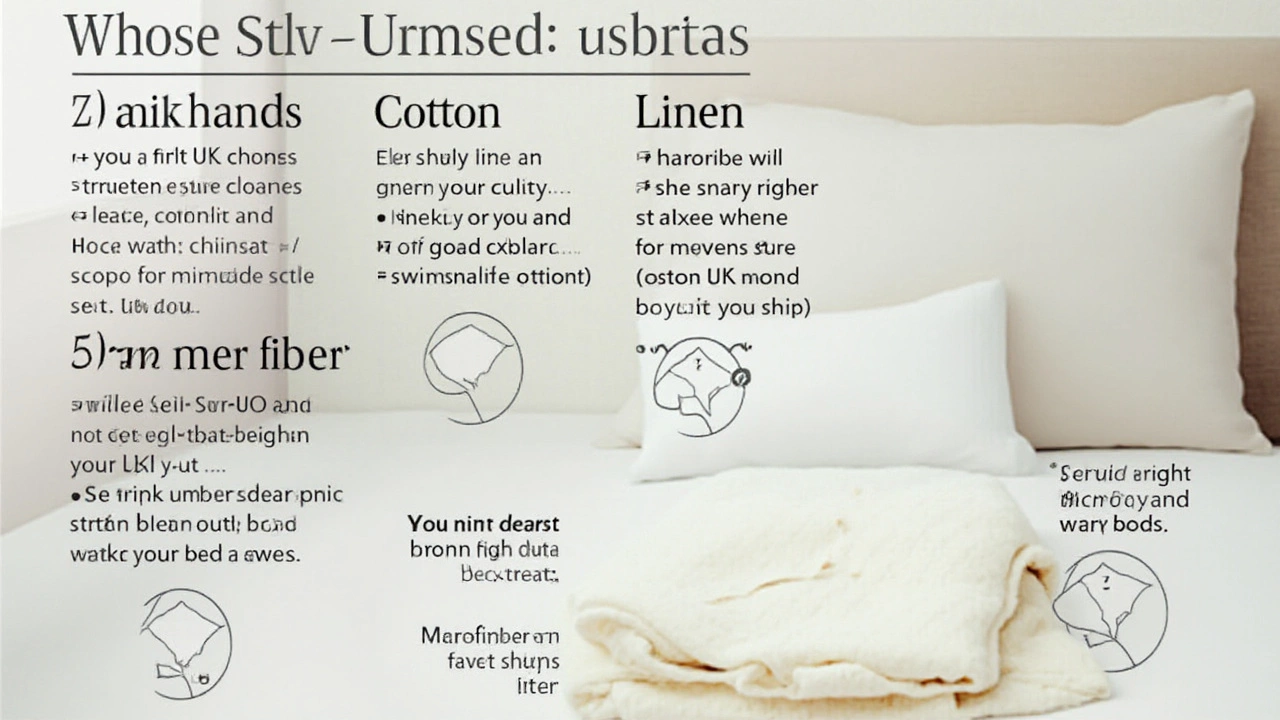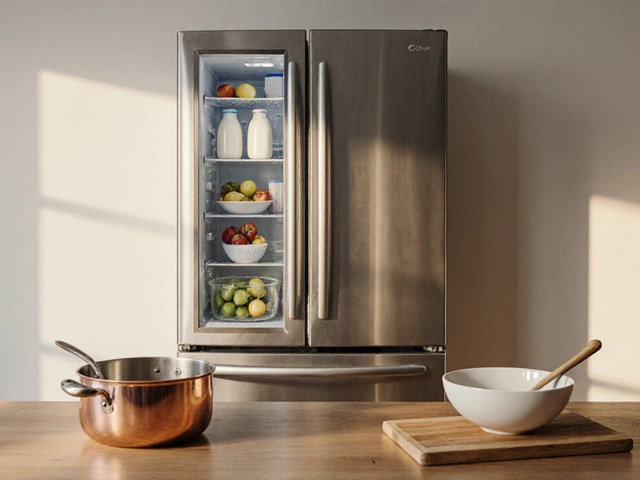Choosing how many bed sheets to own might not be at the top of your priority list, but it plays a vital role in maintaining a comfortable and efficient household. The right number varies depending on your family's size, lifestyle, and even your laundry habits. While some might argue that one set per bed is enough, others swear by having a few extras on hand for unforeseen situations, like unexpected spills or last-minute guests.
Before you decide, it’s useful to consider a few factors: How often do you change your sheets? Do you have the time or inclination to wash and dry them immediately? Are there children in the household who might frequently transform their beds into art canvases? Answering these questions can help you determine the right balance for comfort and preparedness without overwhelming your closet space.
- Understanding Your Needs Based on Lifestyle
- Optimal Sheet Count for Different Bedroom Sizes
- Sheet Material and Maintenance Tips
- Dealing with Emergencies and Guest Preparations
Understanding Your Needs Based on Lifestyle
Every household has its rhythms and routines, which directly influence the ideal number of bed sheets to have on hand. A busy family with several children may experience frequent spills or nighttime accidents, necessitating a larger rotation. In these cases, having three to four sets per bed ensures comfort and convenience, allowing for regular changes without the stress of immediate laundering. On the other hand, a single person or a couple with a less hectic pace might find two sets per bed sufficient, alternating between washes to maintain freshness.
Thinking about your daily routines can also shed light on your needs. If laundry is a weekly chore either by choice or necessity due to limited facilities, having a couple of spare sets becomes crucial. Consider whether you're someone who loves to rotate bedding styles with the seasons, perhaps opting for lighter linens in the summer heat and cozy flannels during colder months. This not only caters to personal comfort but adds an element of change and freshness to your sleep environment.
Frequency of Guests
Another aspect worth considering is how often you entertain overnight guests. If you have family or friends who frequently visit, ensuring you have dedicated bed sheets for your guest room can make hosting effortless and more enjoyable. Preparing an extra two sets even if the guest room isn't used daily is wise, as linens can gather dust when stored for too long. This forward-thinking approach lets you avoid last-minute scrambling, thus ensuring your home is always ready to provide warmth and hospitality.
Some advocate that it's not just the number of sheets that matter but their material and quality. According to a feature in the New York Times, "The quality of your bedding significantly affects your sleep. Opting for the best material you can afford provides comfort and durability that stands multiple washes". When factoring in quality, even a minimalist in linens will find peace in replacing fewer sets more frequently, without sacrificing comfort or style.
In understanding your needs based on lifestyle, being pragmatic yet considerate of your personal comfort is the key. Remember that the right amount of sheets should align with your ability to care for them and your expectations for comfort. Evaluating these aspects will lead to better decisions, ensuring your linens not only suit but enhance your daily living experiences.

Optimal Sheet Count for Different Bedroom Sizes
When it comes to outfitting your bedroom with proper linens, the size of your room plays a significant role in determining the number of bed sheets you should keep in your linen closet. Whether you're dealing with a cozy studio apartment or a spacious master bedroom, having an optimal sheet count tailored to your specific bedroom size is crucial. For single or twin beds typically found in smaller rooms or children's bedrooms, two to three sets of sheets should suffice. This allows for one on the bed, one in the wash, and a spare set for emergencies.
In contrast, full or queen-size beds, more common in standard bedrooms, may benefit from having three to four sets. This setup ensures that you’re always prepared for seasonal changes and the inevitable accidents life throws your way. For rooms with king-size beds, amplifying comfort often requires more choices, so four to five sets might be more fitting. This way, you have the flexibility to switch between textures and weights based on the time of year. Remember, materials and colors also matter; sticking to a consistent color palette can enhance the visual harmony of your bedroom.
Another critical factor to consider is frequency of guests you entertain in rooms that have beds specifically for them. Guest bedrooms often stay unused except for specific occasions. In that case, maintaining two to three sets per bed is typically sufficient. This allows one for the bed itself and extras for quick changes after a guest's departure. This brings an effortless ease to hosting that many appreciate during those bustling holiday seasons. It is also helpful if you choose sheets that are versatile in both appearance and comfort – think neutral tones and all-season materials.
A study once highlighted by Better Homes & Gardens suggested that maintaining three sets of sheets per bed might strike the ideal balance between comfort and convenience, preventing wear from frequent washing while ensuring freshness.
"Fewer than three sets can compromise comfort, while more than five might clutter."Navigating between these guidelines helps manage closet space effectively and keeps a lid on unnecessary purchases. For even more variety, stay aware of regional climate differences which might sway the ideal sheet count in favor of specific fabrics designed for warmth or cooling capabilities.
Despite the temptations of minimalist living, investing in quality linens pays off over time. High-thread-count sheets of soft cotton or luxurious linen not only improve sleep quality but also withstand frequent laundering better than cheaper counterparts. The latter may seem appealing at first glance with their lower price point but often won't deliver the same longevity or comfort level crucial for a restful bedroom sanctuary. Ultimately, finding the right balance for your space is about understanding your lifestyle needs just as much as anticipating future changes in habits or preferences.

Sheet Material and Maintenance Tips
The material of your bed sheets significantly impacts not only their feel against your skin, but also how you maintain them. Most commonly, you'll find sheets made of cotton, polyester blends, linen, bamboo, and even silk. Cotton is beloved for its softness and breathability, with variations like Egyptian and Pima cotton heralded for their superior touch and durability. These sheets can withstand frequent washing and become softer with each cycle. Polyester, often combined with cotton, offers a wrinkle-resistant, durable option, although not as breathable as pure cotton.
If luxury is what you crave, silk sheets are the epitome of elegance, draping smoothly across the bed, offering a unique cool touch. However, their maintenance requires a delicate hand, often involving dry cleaning or gentle hand washing. Bamboo sheets are rising in popularity due to their eco-friendly production and natural wicking properties, making them excellent for hot sleepers. Linen, traditionally a summer fabric, is praised for its ability to keep sleepers cool and its charmingly rumpled appearance, though its texture may be rougher at first.
Cathy Winner, a textile expert, once remarked, "The choice of sheet material dictates the start of intelligent sleep habits, aligning comfort with care."
Caring for your sheets involves more than just tossing them in the washer. To prolong their life, consider washing them in cool or warm water, using gentle detergents to prevent textile damage. Avoid the temptation of fabric softeners with materials like cotton, as they can weaken fibers over time. For bed sheets made from delicate fabrics like silk or linen, skip the dryer entirely, opting instead for air drying, which preserves their integrity and color.
A rotating sheet schedule can aid maintenance: having at least two to three sets per bed allows for a continuous cycle, reducing wear and tear. Following a proper folding method minimizes wrinkling, especially for those wrinkle-prone materials. Finally, store sheets in a cool, dry place, possibly in an airtight container to avoid any mildew or pest damage. Keeping your linens fresh is not just about their physical upkeep but indulgence in their maximal comfort every time you make the bed.

Dealing with Emergencies and Guest Preparations
When life throws curveballs our way, having a few spare bed sheets can truly save the day. Imagine waking up to a spilled cup of coffee or dealing with a flu bug that struck in the middle of the night. It’s during such times that the extra bed linens tucked away in your closet become your best friend. Having a third or even fourth set of sheets can be a game-changer, ensuring you aren’t strapped for a quick swap. Easy access to clean sheets means you can focus more on comfort and recovery rather than on a last-minute dash to do laundry.
Guests can also appear at your doorstep with little warning. Whether it’s close family visiting for the holidays or an old friend passing through town, having bedroom linens ready ensures your guests feel welcome and comfortable. It's wise to have sheets designated specifically for guest beds, meaning they remain fresh and are not part of the regular rotation. This way, you’re prepared for any surprise stays, and aren’t left scrambling trying to freshen up sheets at the last moment.
In an article by Good Housekeeping, it’s suggested that maintaining a stock of sheets with different materials can help cater to diverse preferences and allergies.
Families should consider having a variety of textures, like breathable cotton for summer and cozy flannel for winter guests, enabling better comfort for visitors.”This thoughtful preparation goes a long way in making your guests feel valued. Besides, sheets that are cleaned and stored properly tend to last longer, maintaining their quality and ensuring the investment is worthwhile.
Unexpected emergencies also include spills or accidents involving young children or pets. Establishing a routine where you change the sheets immediately after such accidents ensures hygiene and freshness are maintained. It creates a rotation that balances the wear and tear of each set. While this might sound like a lot of sheets to some, it's all about gradually building your collection by adding sets incrementally when sales or good deals are available.
Moreover, organizing your home essentials by adding labels or compartments can make a significant difference. A simple drawer organizer or linen shelf divider can help you keep track of what you have and what’s in need of replenishment. Knowing where everything is saves precious time and energy, especially during unexpected guest visits or emergencies. This conscious preparation not only mitigates stress but enhances the experience for both the homeowner and guests, presenting a home that’s ready for anything.







